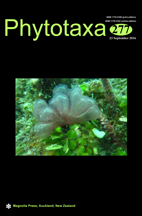Abstract
Lophiostomataceae (Pleosporales, Dothideomycetes) is a ubiquitous family that includes saprobic species associated with a wide variety of substrates in various habitats. DNA based studies have shown numerous genera can be determined within the family Lophiostomataceae that do not always connect to species based on morphological characteristics. An undescribed ascomycete, similar to species of Lophiostomataceae, was collected from dead wood in the South China karst area in Guizhou Province. Phylogenetic analysis of ITS, SSU, LSU and EF1α sequence data revealed that the new taxon nested in the genus Alpestrisphaeria in Lophiostomataceae, thus the novel taxon is introduced as Alpestrisphaeria jonesii. Diagnostic features are erumpent, coriaceous to carbonaceous, subglobose ascomata, a slit-like ostiole with periphyses, filiform pseudoparaphyses, fissitunicate, cylindrical asci and filamentous, 10–15-euseptate, hyaline ascospores. Alpestrisphaeria jonesii can be readily distinguished from the generic type of Alpestrisphaeria, A. terricola by the shape of its asci and ascospores.

